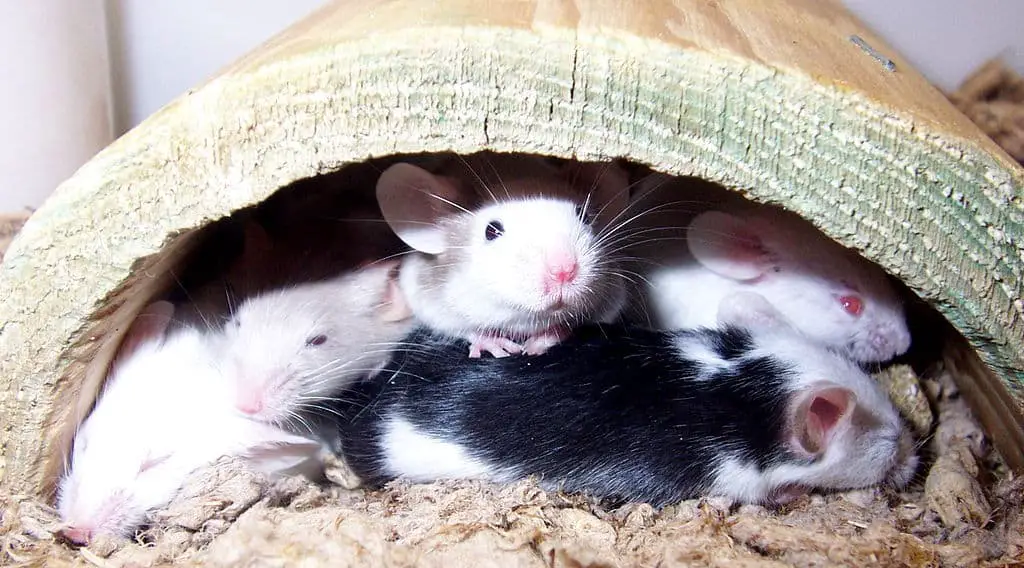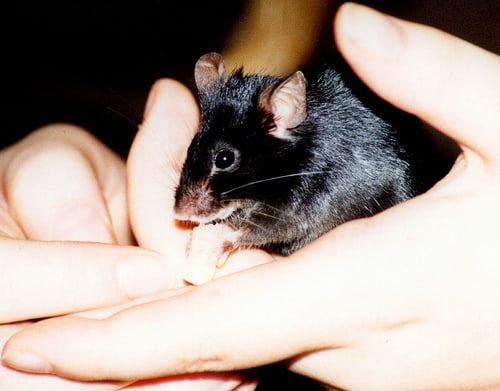So, you’re considering getting a pet mouse, or perhaps you just got one and want to get some more information about your new friend. Whatever the case may be, I’ve got to congratulate you on making a great choice. Mice make excellent pets. They’re intelligent, fun to play with, relatively easy to care for, and can be very affectionate. They make a great addition to any family and are criminally underrated as pets.

In this guide, I’m going to discuss everything you need to know about owning a pet mouse. I will go over their housing, their life expectancy, their behavior, and everything else you should prepare for when you take care of one of these cute rodents.
I’ve said that mice are relatively easy to care for, and this is true. However, there are still some things that you need to be prepared for. After all, no pet is truly low maintenance, and the more knowledge you have, the less likely it’ll be that you’ll come face to face with unexpected situations.
Pet Mouse Care Sheet
| Name of species | Mus musculus domestica |
| Size | 2 to 3 inches |
| Lifespan | 1 to 2 years |
| Temperament | Shy, docile, intelligent |
| Diet | Omnivorous |
| Minimum cage size | 18 inches x 12 inches x 12 inches (for 1 mouse) |
Pet Mouse Overview

The fancy mouse is definitely a great beginner pet. They are cheap, relatively low-maintenance pets which makes them an excellent fit for beginners. Since they are omnivores and do not have a strict diet regime that they should follow either, feeding them is quite straightforward.
However, mice might not be ideal for small kids. They’re quite fragile animals and children usually do not have the patience and self-control to properly handle a mouse. They can easily harm it by accident.
For instance, a young child might want to grab the mouse from its cage at a moment when the mouse does not feel like it. Some children will not realize this and grab it anyway. Due to how delicate the body of the mouse is it can easily get injured or even killed.
Also, for young children, it might be hard to accept the mouse’s short lifespan.
However, for older kids and teenagers mice are a great fit. They’re great companions that can easily be kept in their room. Also, teaching them tricks is a very rewarding experience.
Furthermore, they’re great pets for adults and pretty much everyone who is looking for an animal that doesn’t take up too much space, doesn’t cost too much money, and is not a huge time commitment.
Of course, just because mice are beginner-friendly pets doesn’t mean that they’re only good pets for beginners, they make great pets for beginners and experienced pet owners alike.
Breeds & varieties
Some people are under the impression that there are multiple pet mouse breeds. This is not the case. All pet mice are part of the same species and breed, which is the Fancy Mouse or Mus musculus domestica.
However, there are several varieties of this species that you can choose from. The 7 pet mouse varieties are these:
- Standard
- Satin
- Long hair
- Long hair satin
- Frizzie
- Frizzie Satin
- Hairless
On top of that, they come in a wide variety of different colors and patterns. From white to black, and everything in between.
Behavior and temperament
Mice are less tameable than rats, which behave very similarly to dogs. However, while they’re less tame than rats, they can still be tamed quite easily. Taming your mouse will take a bit of patience, love, understanding, and usually a bit of bribery through the use of food.
When you first get your mouse give him or her a bit of time to get used to its cage, and its new living arrangement. During this time, do not pet them or try to pick them up, only feed them and clean their cage when necessary. Three to four days is usually enough. This time alone allows them to get used to all the new smells and their surroundings. Doing this is especially important if you’ve bought a mouse from a pet store. These mice have been under high amounts of stress from all the people banging on their cages, the loud noises, and the hectic environment.
Once they get used to their cage you can start offering them some treats. When you notice that they start taking the treats directly from your hand it’s a good sign. The next step is allowing them to walk onto your hand and your arm. When they reliably do this you can start picking them up gently.
Make sure to always handle your mouse gently because they’re delicate creatures. Also, if you do not handle them carefully they might bite. But don’t worry, mice usually do not bite, especially mice that are used to being handled by humans. They only do so when they’re scared. However, when they do bite, they can bite pretty hard so be careful.
They’re also highly intelligent animals. Because of their intelligence, they’re very capable of learning tricks and many owners have successfully taught their mice to run agility courses and perform other tricks.
Mice are also incredibly energetic and inquisitive. They’re little bombs of energy so you will often notice your mouse running and goofing around.
Price
By now you’re probably wondering what all of this is going to cost and how much disposable income you need to have to take ownership of a mouse. Luckily, mice are not very expensive pets. I have done a complete breakdown of the cost of owning mice so if you’re interested in that just click the link. I’ll give the raw numbers here to give you an idea of what to prepare for.
Upfront you can expect to spend around $140 for two mice or slightly less for a single mouse. This includes the cost of toys, the mouse itself, its cage, and all the accessories.
Monthly you should expect to spend around $50 for two mice. If you have a single mouse you can cut this down to about $30 per month.
As you can see, mice are not very expensive animals. Making them an excellent choice for pet owners on a budget.
Caring for pet mice

Housing
Before you even buy a mouse you’ve got to have its cage ready. That way, you can put them in their new home immediately. Finding a cage for your mouse shouldn’t be too difficult, but there are some general guidelines that you should keep in mind when deciding on which one to buy.
For starters, you have to make sure that you get a cage that’s big enough. The minimum recommended size for a mouse cage is at least 1 cubic space for 1 rat, with 0.5 added for every additional rat living with them.
If cubic feet are hard to visualize (understandable), go for a cage that’s at least 18 inches x 12 inches x 12 inches.
Keep in mind, that this is the minimum recommended size. When it comes to mice cages, there really isn’t such a thing as “too big”. When in doubt, the bigger their cage is the better option.
Another thing you have to take into consideration is bar spacing. Bar spacing is the distance between the bars of the cage. This spacing should be large enough so that your mice can hold onto the bars and climb, but small enough that your mice can not escape. The ideal bar spacing is 1/4 inch (6 mm). This allows them to not feel like they’re caged in while also not letting them escape.
Something to consider is buying a cage that has multiple “floors” or levels. By doing so you can double, or sometimes even triple, the amount of space your mice have available.
Toys
Mice need toys. They need these for both mental and physical stimulation. These animals have a lot of energy and are very smart and inquisitive. To let out some of that energy, it’s essential that the first thing you get is a wheel for them to run it. The best wheel I’ve found is the Wobust Wodent Wheel. It’s a very safe wheel for them to run around and release some energy in.
Secondly, since they’re rodents they will need chew toys. If they do not have chew toys they can not grind down their teeth, and since their teeth are always growing this can result in health issues. Bamboo or wooden chew toys are a great option.
Climbing toys, tubes, hammocks and hideaways are other essential toys that mice need in their cage.
Feeding
Mice are omnivores and are quite easy to feed. In fact, it’s possible to give your mouse a complete diet by feeding them only pellets. Nevertheless, this is quite monotonous and not the best way to go. The best way to feed a pet mouse is by giving them a combination of pellets, fresh fruits, vegetables, and treats.
Some fruits and vegetables that you can feed your mouse include:
- Apples (excluding the seeds)
- Bananas
- Carrots
- Grapes
- Peas
- Brussel Sprouts
- Romaine lettuce
Good treats are cooked pasta, scrambled egg, or a small portion of nuts. Never feed chocolate as a treat because it’s toxic.
Whenever you feed your mice new foods, always start slow. That way their digestive system can get used to the new food. In addition, if you notice that a certain food product gives them diarrhea, stop feeding it to them.
Time commitment
Pet ownership always comes with a certain amount of time investment. However, not all pets require equal amounts of time. Mice are among the lowest maintenance pets you can find. However, even though they’re low maintenance you still need to set some time aside every day to take care of them.
Naturally, you need to feed them, clean their cage, take them to the veterinarian when they need it, and set aside time to play with them. Overall, make sure that you have at least an hour to spend on your mouse every day.
Lifespan & Health
Mice do not live very long. On average, a healthy pet mouse will live between one and two years. This can be a benefit or a detriment, depending on your situation.
If you’re looking for a pet that’s not a long-term commitment, then a mouse is an excellent choice. On the other hand, if you are looking for a pet to spend many years with, then their short lifespan is obviously not great.
Their short lifespan is definitely something you need to mentally prepare for because you’ll have to say goodbye to them within a few short years.
According to the Merck Vet Manual, some of the most common conditions that pet mice face are disorders that affect the skin and fur, though they can also have more serious disorders such as cancer, abscesses, or wet tail.
Keeping their cage clean and feeding them a healthy diet goes a long way in keeping them healthy, though some diseases are genetic and cannot be prevented.
Social life
A question many aspiring mouse owners have is whether mice can live alone or if they need companions living with them. This is a good question because the answer depends on the sex of your mouse.
If you have a male mouse then you should let him live alone. If you keep multiple male mice in the same cage they will become territorial which will often result in fighting. Their fights can go on until death. Even if fighting does not occur, they will live under elevated levels of stress if they live with another male.
Female mice, on the other hand, can live together with other female mice. You should not keep female mice alone because they will get lonely.
It’s also a mistake to let males and females live together if they’ve not been neutered. If you do this, they’ll reproduce insanely quickly and before you know it you’ll have dozens of baby mice.
Where to buy a pet mouse
When you make the decision to buy a mouse you might be tempted to run to the pet store and buy the first mouse you see. However, that’s not always the best idea. You basically have two choices when it comes to buying a pet mouse: You can either buy it from a pet store or buy one from a breeder.
There are advantages and disadvantages to both. Getting one from a pet store is easier, faster, and cheaper. Buying one from a breeder is more expensive, and they can be more difficult to find, but you do get a mouse of better quality. Also, when you buy from a breeder you have more choice in regards to the color of your mouse’s coat.
Overall, if you want the cheapest and easiest option then you can buy from a pet shop. If you want the best, healthiest mouse possible then go for buying from a breeder.
Final words
Mice are great pets that are unfortunately very underrated. The fact that they’re so low maintenance, cheap, and easy to care for while still being incredibly intelligent, fun, and affectionate makes them a great addition to any home.
Their diet is also quite simple, especially compared to the diets that some other animals have to follow. In addition, the fact that they’re omnivores means that you can feed them a very diverse range of treats, which is a very fun bonding experience for both you and your mouse.
You can buy these sweet critters from both pet shops and breeders, but the best way to get a healthy mouse is to go for a breeder. One thing you do have to keep in mind is their short lifespan. They will not be with you for many years, but the years you will have with them will be amazing and definitely worth it!
- How Long Do American Eskimo Dogs Live? Important Factors and Care Tips - September 29, 2023
- Do American Bulldogs Need Grooming? Essential Tips and Care Guidelines - September 29, 2023
- Do Bengal Cats Enjoy Playing? Essential Tips for Keeping Them Active - September 29, 2023